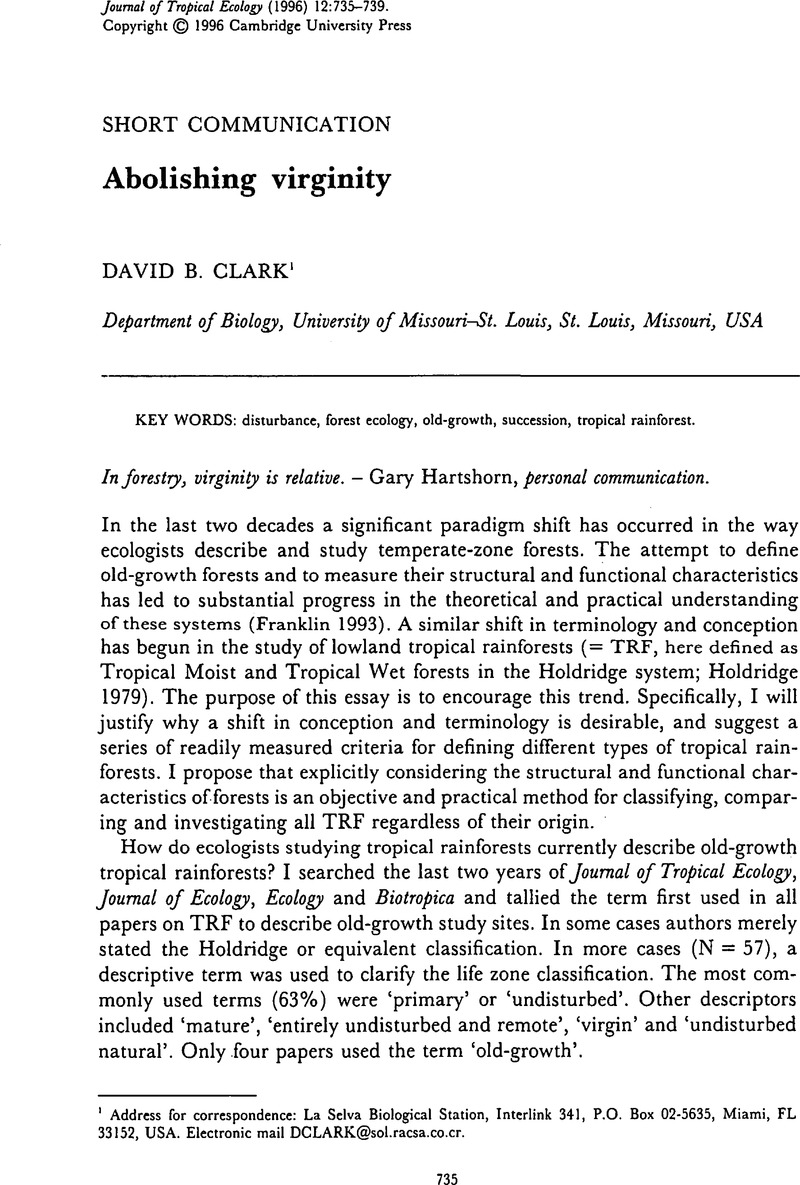Crossref Citations
This article has been cited by the following publications. This list is generated based on data provided by Crossref.
Pizo, Marco Aurélio
1997.
Seed dispersal and predation in two populations ofCabralea canjerana(Meliaceae) in the Atlantic Forest of southeastern Brazil.
Journal of Tropical Ecology,
Vol. 13,
Issue. 4,
p.
559.
Svenning, Jens‐Christian
1999.
Microhabitat specialization in a species‐rich palm community in Amazonian Ecuador.
Journal of Ecology,
Vol. 87,
Issue. 1,
p.
55.
Clark, David B.
Palmer, Michael W.
and
Clark, Deborah A.
1999.
EDAPHIC FACTORS AND THE LANDSCAPE-SCALE DISTRIBUTIONS OF TROPICAL RAIN FOREST TREES.
Ecology,
Vol. 80,
Issue. 8,
p.
2662.
Pizo, Marco A
and
Oliveira, Paulo S
1999.
Removal of seeds from vertebrate faeces by ants: effects of seed species and deposition site.
Canadian Journal of Zoology,
Vol. 77,
Issue. 10,
p.
1595.
Svenning, Jens-Christian
2000.
Small Canopy Gaps Influence Plant Distributions in the Rain Forest Understory1.
BIOTROPICA,
Vol. 32,
Issue. 2,
p.
252.
Lugo, Ariel E
and
Gucinski, Hermann
2000.
Function, effects, and management of forest roads.
Forest Ecology and Management,
Vol. 133,
Issue. 3,
p.
249.
Pizo, Marco A.
2000.
Attack on Chestnut-bellied Euphonia Nestlings by Army Ants.
The Wilson Bulletin,
Vol. 112,
Issue. 3,
p.
422.
Machado, Glauco
and
Pizo, Marco A.
2000.
THE USE OF FRUITS BY THE NEOTROPICAL HARVESTMAN NEOSADOCUS VARIABILIS (OPILIONES, LANIATORES, GONYLEPTIDAE).
Journal of Arachnology,
Vol. 28,
Issue. 3,
p.
357.
Pizo, Marco A.
and
Oliveira, Paulo S.
2000.
The Use of Fruits and Seeds by Ants in the Atlantic Forest of Southeast Brazil1.
Biotropica,
Vol. 32,
Issue. 4b,
p.
851.
Pizo, Marco A.
and
Oliveira, Paulo S.
2000.
The Use of Fruits and Seeds by Ants in the Atlantic Forest of Southeast Brazil1.
BIOTROPICA,
Vol. 32,
Issue. 4,
p.
851.
Svenning, Jens–Christian
2000.
Small Canopy Gaps Influence Plant Distributions in the Rain Forest Understory1.
Biotropica,
Vol. 32,
Issue. 2,
p.
252.
Clark, Deborah A.
Brown, Sandra
Kicklighter, David W.
Chambers, Jeffrey Q.
Thomlinson, John R.
Ni, Jian
and
Holland, Elisabeth A.
2001.
NET PRIMARY PRODUCTION IN TROPICAL FORESTS: AN EVALUATION AND SYNTHESIS OF EXISTING FIELD DATA.
Ecological Applications,
Vol. 11,
Issue. 2,
p.
371.
Francis, John K.
and
Knowles, Oliver Henry
2001.
Age of A2 Horizon Charcoal and Forest Structure near Porto Trombetas, Pará, Brazil1.
Biotropica,
Vol. 33,
Issue. 3,
p.
385.
Guariguata, Manuel R
and
Ostertag, Rebecca
2001.
Neotropical secondary forest succession: changes in structural and functional characteristics.
Forest Ecology and Management,
Vol. 148,
Issue. 1-3,
p.
185.
Francis, John K.
and
Knowles, Oliver Henry
2001.
Age of A2 Horizon Charcoal and Forest Structure near Porto Trombetas, Pará, Brazil1.
BIOTROPICA,
Vol. 33,
Issue. 3,
p.
385.
Pizo, Marco A
and
Simão, Isaac
2001.
Seed deposition patterns and the survival of seeds and seedlings of the palm Euterpe edulis.
Acta Oecologica,
Vol. 22,
Issue. 4,
p.
229.
Armbruster, Peter
Hutchinson, Robert A.
and
Cotgreave, Peter
2002.
Factors influencing community structure in a South American tank bromeliad fauna.
Oikos,
Vol. 96,
Issue. 2,
p.
225.
Thompson, Jill
Brokaw, Nicholas
Zimmerman, Jess K.
Waide, Robert B.
Everham, Edwin M.
Lodge, D. Jean
Taylor, Charlotte M.
García-Montiel, Diana
and
Fluet, Marcheterre
2002.
LAND USE HISTORY, ENVIRONMENT, AND TREE COMPOSITION IN A TROPICAL FOREST.
Ecological Applications,
Vol. 12,
Issue. 5,
p.
1344.
Chinea, J.D.
2002.
Tropical forest succession on abandoned farms in the Humacao Municipality of eastern Puerto Rico.
Forest Ecology and Management,
Vol. 167,
Issue. 1-3,
p.
195.
Phillips, O. L.
Malhi, Y.
Vinceti, B.
Baker, T.
Lewis, S. L.
Higuchi, N.
Laurance, W. F.
Vargas, P. Núñez
Martinez, R. Vásquez
Laurance, S.
Ferreira, L. V.
Stern, M.
Brown, S.
and
Grace, J.
2002.
CHANGES IN GROWTH OF TROPICAL FORESTS: EVALUATING POTENTIAL BIASES.
Ecological Applications,
Vol. 12,
Issue. 2,
p.
576.





